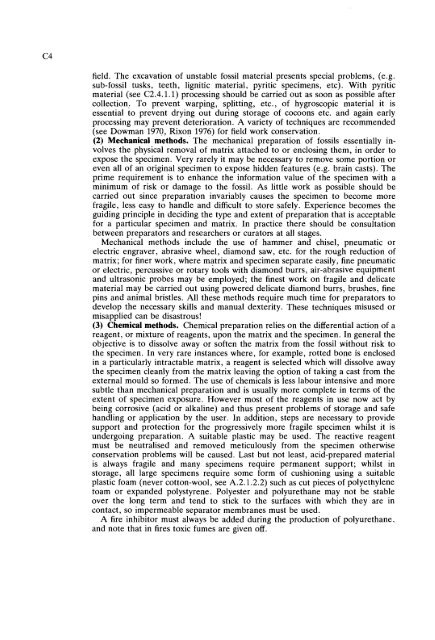GUIDELINES FOR THE CURATION OF GEOLOGICAL MATERIALS
GUIDELINES FOR THE CURATION OF GEOLOGICAL MATERIALS
GUIDELINES FOR THE CURATION OF GEOLOGICAL MATERIALS
Create successful ePaper yourself
Turn your PDF publications into a flip-book with our unique Google optimized e-Paper software.
field. The excavation of unstable fossil material presents special problems, (e.g.<br />
sub-fossil tusks, teeth, lignitic material, pyritic specimens, etc). With pyritic<br />
material (see C2.4.1.1) processing should be carried out as soon as possible after<br />
collection, To prevent warping, splitting, etc., of hygroscopic material it is<br />
essential to prevent drying out during storage of cocoons etc. and again early<br />
processing may prevent deterioration. A variety of techniques are recommended<br />
(see Dowman 1970, Rixon 1976) for field work conservation.<br />
(2) Mechanical methods. The mechanical preparation of fossils essentially involves<br />
the physical removal of matrix attached to or enclosing them, in order to<br />
expose the specimen. Very rarely it may be necessary to remove some portion or<br />
even all of an original specimen to expose hidden features (e.g. brain casts). The<br />
prime requirement is to enhance the information value of the specimen with a<br />
minimum of risk or damage to the fossil. As little work as possible should be<br />
carried out since preparation invariably causes the specimen to become more<br />
fragile, less easy to handle and difficult to store safely. Experience becomes the<br />
guiding principle in deciding the type and extent of preparation that is acceptable<br />
for a particular specimen and matrix. In practice there should be consultation<br />
between preparators and researchers or curators at all stages.<br />
Mechanical methods include the use of hammer and chisel, pneumatic or<br />
electric engraver, abrasive wheel, diamond saw, etc. for the rough reduction of<br />
matrix; for finer work, where matrix and specimen separate easily, fine pneumatic<br />
or electric, percussive or rotary tools with diamond burrs, air-abrasive equipment<br />
and ultrasonic probes may be employed; the finest work on fragile and delicate<br />
material may be carried out using powered delicate diamond burrs, brushes, fine<br />
pins and animal bristles. All these methods require much time for preparators to<br />
develop the necessary skills and manual dexterity. These techniques misused or<br />
misapplied can be disastrous!<br />
(3) Chemical methods. Chemical preparation relies on the differential action of a<br />
reagent, or mixture of reagents, upon the matrix and the specimen. In general the<br />
objective is to dissolve away or soften the matrix from the fossil without risk to<br />
the specimen. In very rare instances where, for example, rotted bone is enclosed<br />
in a particularly intractable matrix, a reagent is selected which will dissolve away<br />
the specimen cleanly from the matrix leaving the option of taking a cast from the<br />
external mould so formed. The use of chemicals is less labour intensive and more<br />
subtle than mechanical preparation and is usually more complete in terms of the<br />
extent of specimen exposure. However most of the reagents in use now act by<br />
being corrosive (acid or alkaline) and thus present problems of storage and safe<br />
handling or application by the user. In addition, steps are necessary to provide<br />
support and protection for the progressively more fragile specimen whilst it is<br />
undergoing preparation. A suitable plastic may be used. The reactive reagent<br />
must be neutralised and removed meticulously from the specimen otherwise<br />
conservation problems will be caused. Last but not least, acid-prepared material<br />
is always fragile and many specimens require permanent support; whilst in<br />
storage, all large specimens require some form of cushioning using a suitable<br />
plastic foam (never cotton-wool, see A.2.1.2.2) such as cut pieces of polyethylene<br />
foam or expanded polystyrene. Polyester and polyurethane may not be stable<br />
over the long term and tend to stick to the surfaces with which they are in<br />
contact, so impermeable separator membranes must be used.<br />
A fire inhibitor must always be added during the production of polyurethane,<br />
and note that in fires toxic fumes are given off.

















